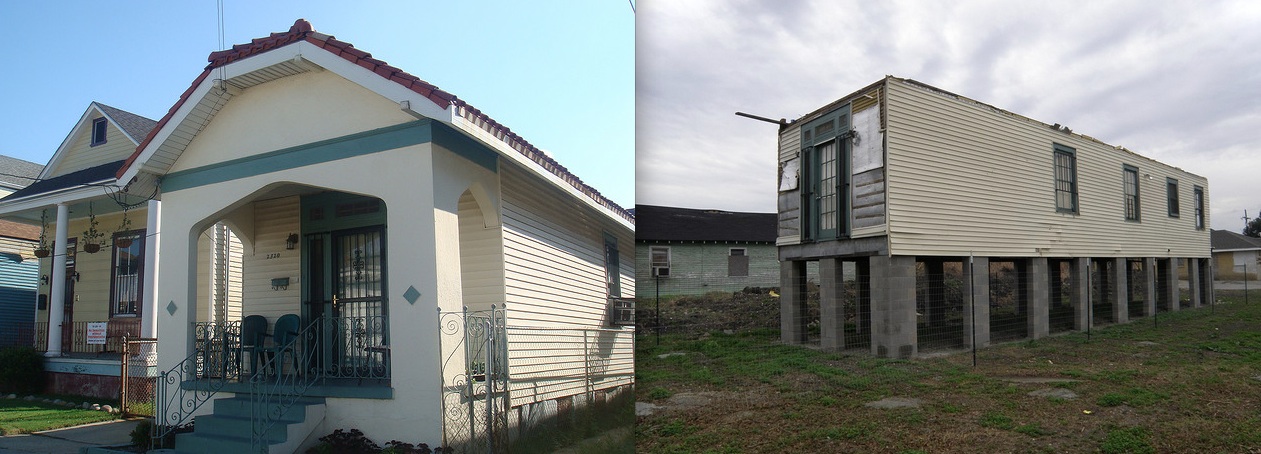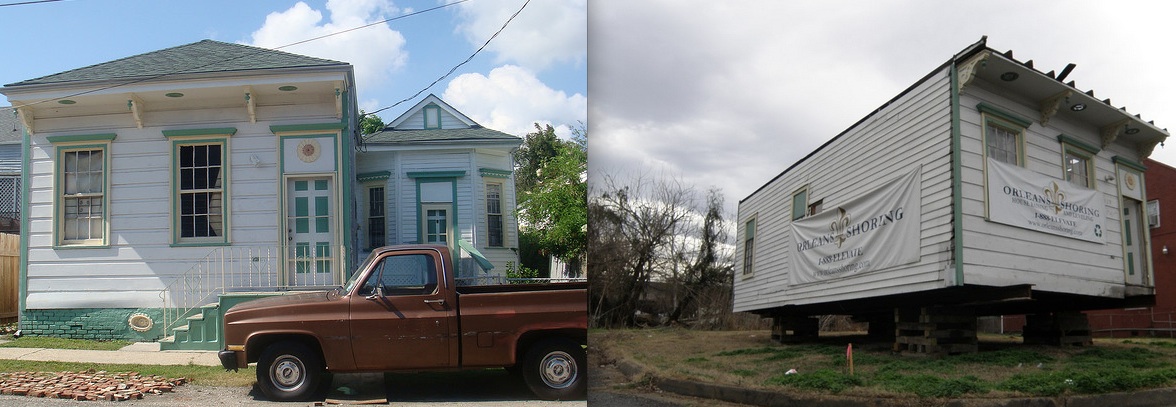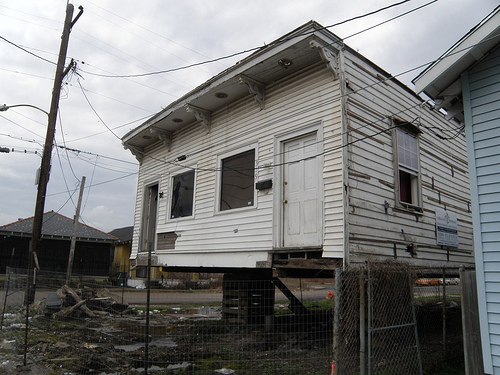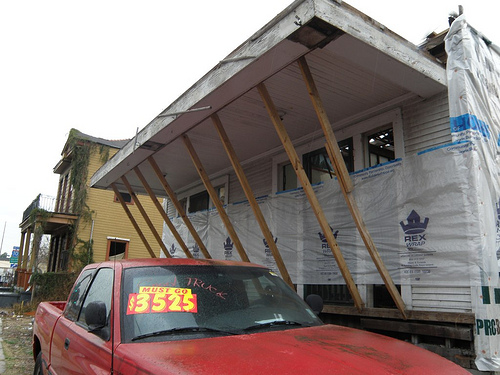Bobbi Rogers and Kevin Krause were deservedly proud of their camelback on Palmyra Street, near Galvez. Part of the influx of young professionals drawn to New Orleans after Hurricane Katrina, the couple bought the place in 2007 and refurbished it in stride with neighbors engaged in one of the city’s more vigorous community revivals. Ironically, top-to-bottom restoration of the house was made possible in part by a $45,000 state grant for historic preservation.
Today the house teeters absurdly atop five-foot concrete piers in the 3600 block of Second Street, a couple of miles from Palmyra. Its camelback has been lopped off, along with the rear rooms that stood beneath it; its roof and windows are open to the elements, its architectural details – those that survived the move – tossed in a heap on the floor.
The house is one of 71 that have been uprooted in a first phase of site preparation for the $2 billion medical complex for the Veterans Affairs and Louisiana State University hospitals, a project about to begin construction on 70 blocks along Tulane Avenue north of Claiborne Avenue. The cost of moving the houses from the Veterans Affairs part of the project: more than $3 million. The price the couple was paid during the condemnation process was not stingy: $350,000.
What has provoked concern is the outcome of the overall taxpayer investment. Most often roofless, only occasionally sheathed in plastic and frequently shorn of the detailing that made them quaint and worth saving, the houses are strewn about the city’s older neighborhoods like giant packing crates.

Preservationists had hailed plans to relocate the houses as at least a consolation prize in a long, losing struggle against aspects of the hospital plans.
Brad Vogel, with the National Trust for Historic Preservation, made a point of watching as the work commenced, only to come away appalled.
“I watched workers sledge-hammering and dropping architectural elements into rubble piles,” Vogel recalled recently.
Given the constraints imposed by overhanging wires and the turning radius of trucks carrying the uprooted houses around corners and across town, roofs and upper floors were lopped off as were the back rooms of any structure longer than trucks could accommodate.
At one house that Vogel monitored, “subcontractors for the state did not even do basic salvage on the upper floor as it was taken off,” he said.

Builders of Hope, the national company that landed the contract to move the houses, insists they are salvageable even after months of neglect on new lots. Company president Lew Schulman said the reason they sit roofless and open to foul weather and vagrants is because months elapsed between moving the houses and the city coming up with the money to re-roof and seal them, the part of the process called “dry-in.” Indeed, the city and Builders of Hope this week were working on a memorandum of understanding on dry-in procedures that will lead to completion of the job, according to Ryan Berni, a spokesman for Mayor Mitch Landrieu.
Schulman predicts that once an agreement is struck, the dry-in work will take another 45 to 60 days. “We can’t start work until a contract is completed,” he said.
Preservationists are left to wonder if the houses haven’t been damaged as irreparably as they would have been if left in the path of bulldozers.
Initially touted as a fine example of potential synergies in post-disaster New Orleans, the plans to coordinate rebuilding the VA facility and LSU’s Charity Hospital soon drew fire.
First came the announcement that the blueprint for the medical center would not include rehabilitation of Charity Hospital, the art-deco architectural gem steeped in municipal and medical history. The hospital establishment, spearheaded by the LSU and Tulane University medical schools, said purging the 1930’s building of asbestos and retrofitting it as a modern hospital would be too costly, a claim countered in a study financed by preservationists.
Proponents of new construction also argued that economies of scale could be realized by combining food services, labs, blood banks and other infrastructure serving both hospitals – a vision that was soon discarded as development plans moved onto separate tracks due to a dispute over FEMA funding that slowed the LSU part of the project. (The VA had its own funding sources.)
After an arbitrator ordered FEMA in early 2010 to jack up the amount it would pay to replace Charity, the momentum toward an all-new, north-of-Claiborne medical complex was unstoppable. As a last hurrah, preservationists committed themselves to moving the houses out of the bulldozers’ path. By the time Mayor Mitch Landrieu came into office last spring, their clamor was too loud to ignore.
Nobody with an ear for New Orleans politics seriously thought that concern for older housing stock was going to derail pans for the giant $2 billion medical complex, not at a time of national recession and in a city still recovering from catastrophe. But preservationists cheered when Landrieu announced a temporary moratorium on demolition of the old houses and vowed to tweak site plans that had been declared mundane by urban planners.
The rim shot ending the moratorium drum roll was Landrieu’s announcement that he had freed up $3.2 million in federal Community Development Block Grant funding to move the remaining 71 houses from within the VA part of the hospital complex’s footprint. The Greater New Orleans Housing Alliance was engaged to put out the word that the houses would be given at no cost to housing non-profits able to line up empty lots. Builders of Hope was hired to move the houses at government expense.

The contract said nothing about roofs being either removed or restored. In hindsight, Vogel says the house-moving plans weren’t thought through carefully enough.
“If a meaningful house-moving program had been in the mix earlier in the planning stages,” Vogel said, movers “wouldn’t have been forced by the timeline to do things like remove roofs to get under wires.”
The length of the delay between moving the houses and re-sealing them was not the first snafu. While various non-profits came forward to take charge of the moved houses, the operating assumption that they would be welcomed by neighborhoods full of empty lots proved unreliable and had to be revisited.
The Neighborhood Development Foundation, a group active in the Hoffman Triangle area between Broadmoor and Central City, was approached about accepting as many as 20 houses on vacant lots owned in the triangle by NORA, the New Orleans Redevelopment Authority. One look at the roofless boxes prompted an emphatic no-thanks, said Kim Washington, the foundation’s asset manager. The city prevailed and the houses arrived anyway, the sparsely populated triangle having been deemed a good place for housing infill.

More typically, neighbors woke up to a done deal and didn’t like what they saw. The family that operates Two Sisters, a soul food restaurant in the 200 block of North Derbigny Street, sees the “raggedy houses” as a neighborhood blight.
“They should have torn them down, they really should have. They look like a fire hazard,” said one of the owners, a Ms. Tate who asked that her first name not be published.
Schulman says Builders of Hope’s strategy for placing the houses was to avoid “gentrifying” areas, and indeed some decidedly non-gentrified areas were found, among them a used car lot at the corner of Orleans and Claiborne Avenue where the shell of a house now stands.
The car lot structure is one of 31 houses awarded to Providence Housing, the non-profit better known for its involvement in redevelopment of the former Lafitte public housing development a few blocks down Orleans Avenue. Providence Housing spokeswoman Andreanecia Morris said Providence Housing hopes eventually to restore architectural detailing to the house in the used car lot.

One argument in favor of moving the houses was to rescue them from hopelessly blighted blocks. But the fate of the trim, two-story house that once stood at 321 South Galvez Street makes a mockery of the argument that better neighborhoods were in store for houses that got moved, preservationists say. Today the house formerly on Galvez stands not many blocks away at 2536 Palmyra Street, amid housing far more dilapidated than the neighborhood where it survived for a century. Next door is an uninhabitable double a few gusts of wind or a cold-night campfire away from complete destruction. As with other houses, the entire second floor, gallery included, was cut off the Galvez Street house as it was moved. The building had been purchased for $210,000 as part of the relocation process.

For all the missteps, Vogel of the National Trust is optimistic that the relocated houses can be resuscitated and an architectural heritage preserved. So is Scott Hutcheson, an adviser to Landrieu on cultural economy. Hutcheson contends that when the houses are put back together, no one will know if they stood open for two days or two months. Krause is not so sure.
“In our case, $10,000 worth of kitchen cabinets are still hanging in the kitchen soaking up rain for the last three months, not to mention the hardwood floors,” he said. “Residents weren’t allowed to take anything out under threat of arrest unless we paid for it. What a waste. The city strikes again.”
Those who fought to relocate the houses, acknowledge the program’s shortcomings but frame the whole venture as an important new chapter in the annals of historic preservation – something never before tried on this scale.
”Overall, we’re encouraged by the house-moving precedent,” Vogel said.
Another rarity in preservation history: New Orleans has an opportunity for a mulligan, a do-over, a chance to learn from its gaffes and try again to get things right. Plans call for moving another group houses that are in LSU’s part of the footprint. Indeed, negotiations for that effort are underway.
Sandra Stokes, vice chair of the Foundation for Historical Louisiana, hopes the outcome is a happier one this time.
“Now that the state has announced it will start to move homes from the LSU site, we hope they can proceed with a more appropriate approach such as moving houses with roofs attached and moving them into appropriate historic centers,” she said.

